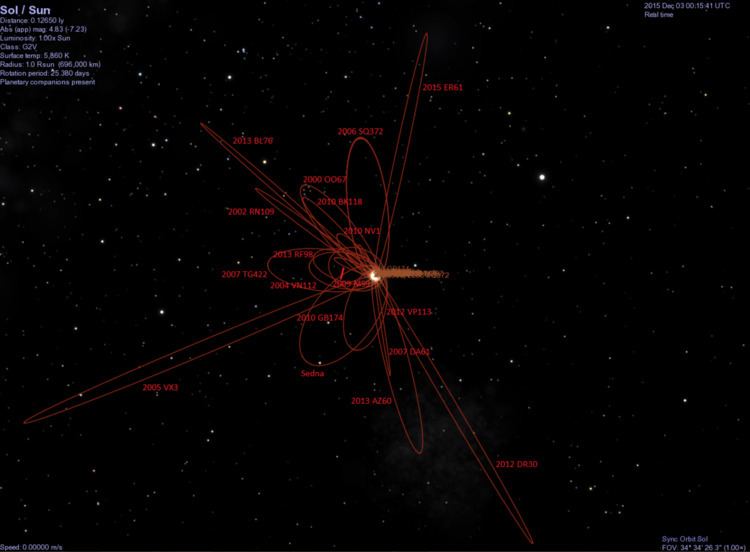Discovered by Mt. Lemmon Survey Observation arc 1160 days (3.18 yr) Absolute magnitude 10.2 Apparent magnitude 19.8 | Discovery date January 10, 2013 Discovered 10 January 2013 Asteroid group Centaur Discoverer Mount Lemmon Survey | |
 | ||
Aphelion 1,450.1 AU (216.93 Tm) (Q) Perihelion 7.9103 AU (1.18336 Tm) (q) Similar 2012 DR30, 2013 BL76, 2007 TG422, 2003 QX113, 2008 ST291 | ||
2013 AZ60 is a small Solar System body (extended centaur) from the scattered disk or inner Oort cloud. 2013 AZ60 has the 8th-largest semi-major axis of a minor planet not detected outgassing like a comet (2013 BL76, 2005 VX3 and 2012 DR30 have a larger semi-major axis).
2013 AZ60 came to perihelion in November 2014 at a distance of 7.9 AU from the Sun (inside of the orbit of Saturn). With an absolute magnitude (H) of 10.2, 2013 AZ60 has an estimated diameter of 40 km. Comet Hale–Bopp, which is roughly the same size, was not discovered until it was 7.2 AU from the Sun and had started outgassing CO. 2013 AZ60 may be discovered to be cometary as it comes to perihelion. It comes to opposition at the start of April.
After leaving the planetary region of the Solar System, 2013 AZ60 will have a barycentric aphelion of 828 AU with an orbital period of 8500 years. In a 10 million year integration of the orbit, one of the 3-sigma clones is ejected from the Solar System.
Physical characteristics and orbit
A 2016 study found 2013 AZ60 to have a comet-like albedo of 2.9% (darker than any other known ejected centaur) and a color typical of D-type asteroids. It is unknown if it is a so-called "super comet" or an extinct comet, considering its large distance from the Sun. It was also determined that 2013 AZ60 has a diameter of 62.3 ± 5.3 kilometers, larger than initially believed. A light curve analysis found it to have a rotation period of 9.39 ± 0.22 hours, typical of asteroids its size. No significant satellites were detected.
It was also found that 2013 AZ60 is on an extremely unstable orbit, with a ~64% chance of being ejected from the Solar system in 1 million years, and a ~25% chance of being ejected in the next 500,000 years, as well as a 4.2% chance of its orbit venturing into the neighborhood of Earth.
